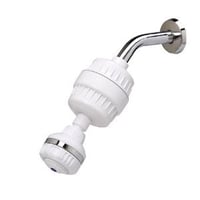 Whilst ‘temperature’ remains the traditional and mainstay method of control for maintaining water hygiene safety within health and non-health estates, respective guidance for the safe management of water systems acknowledges that this may not always be achievable. As such, this has given rise to the use of ‘supplementary control’ strategies, of which ‘filtration’ is one such strategy.
Whilst ‘temperature’ remains the traditional and mainstay method of control for maintaining water hygiene safety within health and non-health estates, respective guidance for the safe management of water systems acknowledges that this may not always be achievable. As such, this has given rise to the use of ‘supplementary control’ strategies, of which ‘filtration’ is one such strategy.
The intention of this blog is to answer the following in relation to point of use (POU) filters:
- What are POU water filters and how do they work?
- When are POU water filters indicated for use and for how long?
- Where can POU water filters be used?
- What precautions should be taken when using POU water filters?
What are POU water filters and how do they work?
Filtration (and its use within water systems…) is considered a ‘physical’ disinfection strategy that utilises semipermeable media to remove contaminants from water. The type and size of media indicated for use are contingent upon the application. Therefore, in some instances, there may be a requirement to indicate the use of coarse filtration to remove heavy particulate from water systems, whereas comparatively ‘finer’ filtration may be indicated for other applications… such as POU filtration.
It is important to distinguish between the different types of filtration in order to determine what may be considered suitable and sufficient for a given application. Moreover, POU filtration requires the use of ‘sterilising grade’ filtration media in order to produce a sterile filtrate. Sterilising grade filters utilise at least a 0.2µm rated filter media in accordance with associated standards (ASTM F838… which entails using a destructive test with a proteobacteria genus (Brevundimonas diminuta)), to help ensure that users of outlets (taps and showers) are protected from waterborne bacteria, including Legionella at the point of care/use – where such filters are in use.
When are POU water filters indicated for use and for how long?
In all reasonableness, POU water filters may therefore ‘complement’ rather than replace estates regimens by allowing affected outlets/water systems to be kept in regular service whilst requisite reactive maintenance works are undertaken. Whilst there may be instances where such filters are used for prolonged periods of time (protecting high-risk/immunocompromised persons), these filters are typically indicated for short-term use – until ‘control’ is re-established, as the continued use of POU filters may slow the flow of water to/from a given outlet and as such may increase the associated contamination risk – including but not limited to: the accumulation of particulate/nutrients that may encourage the growth of waterborne pathogens.
allowing affected outlets/water systems to be kept in regular service whilst requisite reactive maintenance works are undertaken. Whilst there may be instances where such filters are used for prolonged periods of time (protecting high-risk/immunocompromised persons), these filters are typically indicated for short-term use – until ‘control’ is re-established, as the continued use of POU filters may slow the flow of water to/from a given outlet and as such may increase the associated contamination risk – including but not limited to: the accumulation of particulate/nutrients that may encourage the growth of waterborne pathogens.
Where can POU water filters be used?
It’s therefore prudent to consider the impact of ‘differential pressure’ (as filters become fouled the ‘filtrate’ (water downstream of the filter) will move slower) on water systems where filters are in use to:
- Identify whether it is viable to use such filters ‘prior to installation’ by understanding water system pressure and the anticipated impact upon this once filters have been installed. Filter manufacturers will often be able to advise on the pressure drop to be expected from a ‘clean’ filter, so that prospective users may determine suitability. Neglecting to consider this may result in unfavourable performance (slow or no flow through the filter and the reduction of water velocity at the filter point/within the local system).
- Mitigate water hygiene/legionella risk (particulate/bacterial) associated with slow moving water.
What precautions should be taken when using POU water filters?
In summation, POU water filters present the option of keeping outlets (taps/showers) in regular service when contaminated by waterborne pathogens (P. aeruginosa, Legionella) – until all reactive maintenance works have been completed with evidence provided that outlets are safe to use without filters.
However, it is prudent to exercise some caution where filters are installed – considering the associated impact on differential pressure and as this increases (as filter media becomes more fouled), the filtrate will move slower. In addition, it is important to consider that the rate in which a filter blocks is ‘not’ typically linear and will be contingent upon the amount of contamination present within a given water system – which may require further monitoring to ensure that the use of filters remain fit for purpose.
Finally, where filters are in use, there should be a suitable and sufficient water safety record keeping system in place to ensure that filters continue to be used in accordance with manufacturer instructions (including but not limited to the capture of installation/removal dates and cleaning procedures (if applicable)). The rationale and method statement for filter use should also be captured within the organisational water safety plan or Legionella written scheme of control, so that all involved with the use/handling/cleaning/management of these products are aware of the agreed procedures.
Feel free to reach out if you have any questions about this blog or if you would like to consult with one of our experts for further advice on water hygiene.
Editor’s Note: The information provided in this blog is correct at date of original publication – June 2021
© Water Hygiene Centre 2021


![Authorised Person [Design] course - Now available](https://no-cache.hubspot.com/cta/default/2896031/80efe1f0-a05a-4046-8ba2-6418d3525fbd.png)





